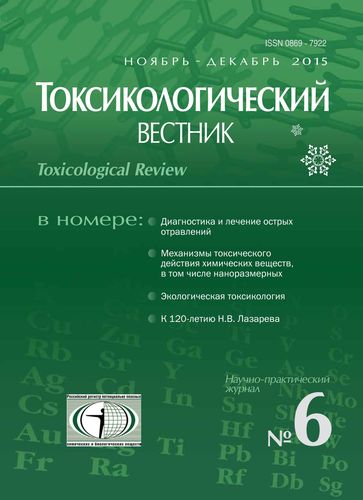A STUDY OF ATROPINE INFLUENCE ON ACHE AND BCHE GENES EXPRESSION IN RATS EXPOSED TO MALATHION POISONING
- 作者: Babkin A.V.1, Berdinskih I.S.1, Osechkina N.S.2, Nazarov G.V.1, Yudin M.A.1, Bykov V.N.1
-
隶属关系:
- Scientific Research Test Institute of Military Medicine of Medical Military Academy named after S.M. Kirov (The Russian Federation Department of Defense)
- Federal State Scientific Institution «Institute of Toxicology» Federal Medico-Biological Agency of Russia
- 期: 编号 6 (2015)
- 页面: 22-26
- 栏目: Articles
- ##submission.datePublished##: 04.12.2015
- URL: https://clinpractice.ru/0869-7922/article/view/641358
- DOI: https://doi.org/10.15690/vramn521
- ID: 641358
如何引用文章
全文:
详细
Levels of expression of Ache and Bche genes in tissue samples were investigated in rats exposed to malathion in dose of 1 LD50 and following atropine treatment. Malathion poisoning causes statistically significant decrease in levels of expression of Ache and Bche genes in brain and liver. The decrease of expression of these genes was greater than 50% and remained at this level during 14 days. It was shown that atropine treatment prevents decrease in Ache gene expression in brain. These findings suggest the possibility of gene expression level assessment in brain during the screening of promising treatments for OP poisoning.
作者简介
Aleksandr Babkin
Scientific Research Test Institute of Military Medicine of Medical Military Academy named after S.M. Kirov (The Russian Federation Department of Defense)
编辑信件的主要联系方式.
Email: noemail@neicon.ru
Научный сотрудник НИИИ ВМ ВМедА им. С.М. Кирова Министерства обороны Российской Федерации, 195043, г. Санкт-Петербург, Российская Федерация
e-mail: babkinnik@yandex.ru
俄罗斯联邦Irina Berdinskih
Scientific Research Test Institute of Military Medicine of Medical Military Academy named after S.M. Kirov (The Russian Federation Department of Defense)
Email: noemail@neicon.ru
Научный сотрудник НИИИ ВМ ВМедА им. С.М. Кирова Министерства обороны Российской Федерации, 195043, г. Санкт-Петербург, Российская Федерация
e-mail: irina_berdinskih@mail.ru
俄罗斯联邦Natalya Osechkina
Federal State Scientific Institution «Institute of Toxicology» Federal Medico-Biological Agency of Russia
Email: noemail@neicon.ru
Научный сотрудник ФГУН «Институт Токсикологии» ФМБА России, 192019, г. Санкт-Петербург, Российская Федерация
e-mail: dunats@rambler.ru
俄罗斯联邦Georgiy Nazarov
Scientific Research Test Institute of Military Medicine of Medical Military Academy named after S.M. Kirov (The Russian Federation Department of Defense)
Email: noemail@neicon.ru
Доктор химических наук, доцент, начальник отдела НИИИ ВМ ВМедА им. С.М. Кирова Министерства обороны Российской Федерации, 195043, г. Санкт-Петербург, Российская Федерация
e-mail: denis-100@list.ru
俄罗斯联邦Mikhail Yudin
Scientific Research Test Institute of Military Medicine of Medical Military Academy named after S.M. Kirov (The Russian Federation Department of Defense)
Email: noemail@neicon.ru
Кандидат медицинских наук, доцент, заместитель начальника отдела НИИИ (ВМ) ВМедА им. С.М. Кирова, 195043, г. Санкт-Петербург, Российская Федерация
e-mail: mikhail.judin@gmail.com
俄罗斯联邦Vladimir Bykov
Scientific Research Test Institute of Military Medicine of Medical Military Academy named after S.M. Kirov (The Russian Federation Department of Defense)
Email: noemail@neicon.ru
Доктор медицинских наук, профессор, начальник НИИЦ (МБЗ) НИИИ (ВМ) ВМедА им. С.М. Кирова, 195043, г. Санкт-Петербург, Российская Федерация
e-mail: bykov_imm@yahoo.com
俄罗斯联邦参考
- Shilov V.V. et al. Study of the effectiveness of drugs in experimental models of poisoning neuropathy in malathion. //Occupational medicine and industrial ecology. 2013; 8: 13-18 (in Russian).
- Aurbek N. Suitability of human butyrylcholinesterase as therapeutic marker and pseudocatalytic scavenger inorganophosphate poisoning: A kinetic analysis. //Toxicology. 2009; 259: 133-139.
- Naik R.S. et al. Development and validation of a simple assay for the determination of cholinesterase activity in whole blood of laboratory animals.// J. Appl. Toxicol. 2013; 33 (4): 290-300.
- Bahar F.G. et al. Species difference of esterase expression and hydrolase activity in plasma.// J. Pharm. Sci. 2012; 101 (10): 3979-3988.
- Bajgar J. et al. Changes of cholinesterase activities in the rat blood and brain after sarin intoxication pretreated with butyrylcholinesterase. Drug. Chem. Toxicol. 2007; 30 (4): 351-3
- Babkin A.V. et al. Association of Bche gene polymorphic variants with activity of rat butyrylcholinesterase after exposure to malathion.// Toxicological Review. 2014; 5: 16-20 (in Russian).
- Lopez-Granero C. et al. Chlorpyrifos-, diisopropylphosphorofluoridate-, and parathion-induced behavioral and oxidative stress effects: are they mediated by analogous mechanisms of action. // Toxicol. Sci. 2013; 131 (1): 206-216.
- Xing, H. et al. Alterations in mRNA expression of acetylcholinesterase in brain and muscle of common carp exposed to atrazine and chlorpyrifos. //Ecotoxicol. Environ. Saf. 2010; 73 (7): 1666-16
- Mironov A.N. Guidelines for pre-clinical trials of drugs.Part Moscow. 2012 (in Russian).
- Osechkina N.S. et al. The expression’s influence and polymorphism of genes, which encode gaba-receptors, on heft ethanol influence in laboratory rats. // Toxicological Review. 2014; 6: 22-28 (in Russian).
- Rhee J. S. et al. Effect of pharmaceuticals exposure on acetylcholinesterase (AchE) activity and on the expression of AchE gene in the monogonont rotifer Brachionuskoreanus. //Comp. Biochem. Physiol. C. Toxicol. Pharmacol. 2013; 158 (4): 216-224.
- Zhen H. Toxic effects of HgCl2 on activities of SOD, AchE and relative expression of SOD, AChE, CYP1A1 of zebrafish. //Ecotoxicology. 2014; 23 (10): 1842-1845.
- Charoenying T. et al. Effects of paraoxon on neuronal and lymphocytic cholinergic systems.//Toxicol. Pharmacol. 2011; 31 (1): 119-128.
补充文件







